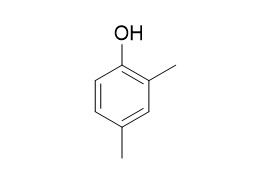2,4-Dimethylphenol
2,4-Dimethylphenol has toxic effects.
Inquire / Order:
manager@chemfaces.com
Technical Inquiries:
service@chemfaces.com
Tel:
+86-27-84237783
Fax:
+86-27-84254680
Address:
1 Building, No. 83, CheCheng Rd., Wuhan Economic and Technological Development Zone, Wuhan, Hubei 430056, PRC
Providing storage is as stated on the product vial and the vial is kept tightly sealed, the product can be stored for up to
24 months(2-8C).
Wherever possible, you should prepare and use solutions on the same day. However, if you need to make up stock solutions in advance, we recommend that you store the solution as aliquots in tightly sealed vials at -20C. Generally, these will be useable for up to two weeks. Before use, and prior to opening the vial we recommend that you allow your product to equilibrate to room temperature for at least 1 hour.
Need more advice on solubility, usage and handling? Please email to: service@chemfaces.com
The packaging of the product may have turned upside down during transportation, resulting in the natural compounds adhering to the neck or cap of the vial. take the vial out of its packaging and gently shake to let the compounds fall to the bottom of the vial. for liquid products, centrifuge at 200-500 RPM to gather the liquid at the bottom of the vial. try to avoid loss or contamination during handling.
The Japan Society for Analy. Chem.2017, 66(8):613-617
Theoretical and Experimental Plant Physiology 2022, 34,53-62
Korean Journal of Plant Resources2021, 34(1):52-58.
United States Patent Application2020, 20200038363
J Food Compos Anal2017, 62:197-204
Phytother Res.2022, 10.1002:ptr.7626.
Neurochem Res.2021, s11064-021-03449-0
Biol Pharm Bull.2023, 46(2):245-256.
HortTechnology2016, 26(6):816-819
Mol Med Rep.2014, 9(5):1653-9
Related and Featured Products
Pesticide Biochemistry & Physiology, 2006, 85(3):174-180.
2,4-D and MCPA and their derivatives: Effect on the activity of membrane erythrocytes acetylcholinesterase (in vitro).[Reference:
WebLink]
METHODS AND RESULTS:
The effect of 2,4-dichlorophenoxyacetic acid (2,4-D), 4-chloro-2-methylphenoxyacetic acid (MCPA), and their derivatives: phenol, 2,4-dichlorophenol (2,4-DCP), 2,4-Dimethylphenol (2,4-DMP), and catechol on the activity of acetylcholinesterase (AChE, EC 3.1.1.7) in human erythrocytes was studied. Phenol, MCPA, and 2,4-DMP did not significantly change AChE activity in human erythrocytes (in vitro). Decrease of AChE activity was observed under the highest applied dose of 2,4-D—500 and 1000 ppm. Decrease of AChE activity exposed to 2,4-DCP and catechol was noted and depended on the doses of applied compounds. The relationship between activities and substrate concentrations (curves) was analyzed for reactions of acetylcholinesterase. Catalytic constants Km and Vmax were calculated from the Michaelis curve. Statistically significant decrease of Vmax and Km was observed in the activity of AChE incubated with 2,4-DCP and catechol, revealing mixed inhibition type of AChE inhibition (this compound may affect not only on enzyme but also on complex ES as well). 2,4-D decreases Vmax but do not change Km value, what reveals non-competitive type of AChE inhibition by this compounds. Non-competitive inhibition does not depend on the substrate concentrations but only on the inhibitor concentration and its Ki value, characterizes the affinity of inhibitors towards enzyme.
CONCLUSIONS:
In conclusion, changes of AChE activity upon 2,4-D, 2,4-DCP, and catechol are the consequences of direct interactions between compounds and the enzyme and indirect via membrane modification and increase of Reactive Oxygen Species.
Archives of Environmental Contamination & Toxicology, 1982, 11(1):73-78.
Effects of phenol, 2,4-dimethylphenol, 2,4-dichlorophenol, and pentachlorophenol on embryo, larval, and early-juvenile fathead minnows (Pimephales promelas).[Pubmed:
7073320]
METHODS AND RESULTS:
Embryos of fathead minnows were more resistant to phenol, 2,4-Dimethylphenol (2,4-DMP), 2,4-dichlorophenol (2,4-DCP), and pentachlorophenol (PCP) than were larval or juvenile life stages. Growth of 28-day-old fish was the most sensitive indicator of stress during exposures to phenol, 2,4-DMP, and PCP, whereas survival was the most sensitive indicator of toxic effects from 2,4-DCP exposure.
CONCLUSIONS:
Based on these effects, the estimated maximum acceptable toxicant concentration for fathead minnows in Lake Superior water lies between 1,830 and 3,570 micrograms/L for phenol; 1,970 and 3,110 micrograms/L for 2,4-DMP; 290 and 460 micrograms/L for 2,4-DCP; and 44.9 and 73.0 micrograms/L for PCP.
Talanta, 2010, 81(4-5):1630-1635.
2,4-Dimethylphenol imprinted polymers as a solid-phase extraction sorbent for class-selective extraction of phenolic compounds from environmental water[Pubmed:
20441950]
METHODS AND RESULTS:
A molecularly imprinted polymer (MIP) was prepared using 2,4-Dimethylphenol (2,4-DMP) as template. The synthesis is optimized by using three different porogens, chloroform, acetonitrile and toluene. The MIP was used as a class-selective sorbent in molecularly imprinted solid-phase extraction (MIP-SPE) for pre-concentration and determination of phenolic compounds from the environmental water. The difference in recognition selectivity of the polymer columns was observed in HPLC system. The variables affecting the extraction efficiency of MIP-SPE procedure were systematically investigated to facilitate the class-selective extraction of phenols from spiked water samples. The spiked aqueous solution was adjusted to pH 6.0 before being percolated through the MIP-SPE cartridge at the flow rate of 0.5mLmin(-1). After rinsing with dichloromethane, the bound phenolic compounds were desorbed with acetonitrile containing 5% aqueous ammonia.
CONCLUSIONS:
The developed MIP-SPE method was demonstrated to be applicable to the analysis of phenolic compounds in the environmental water.



